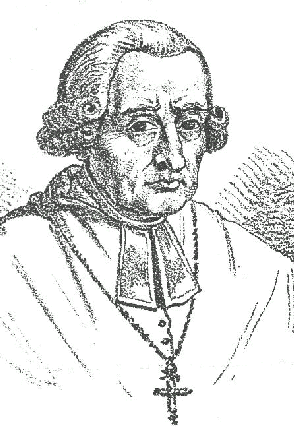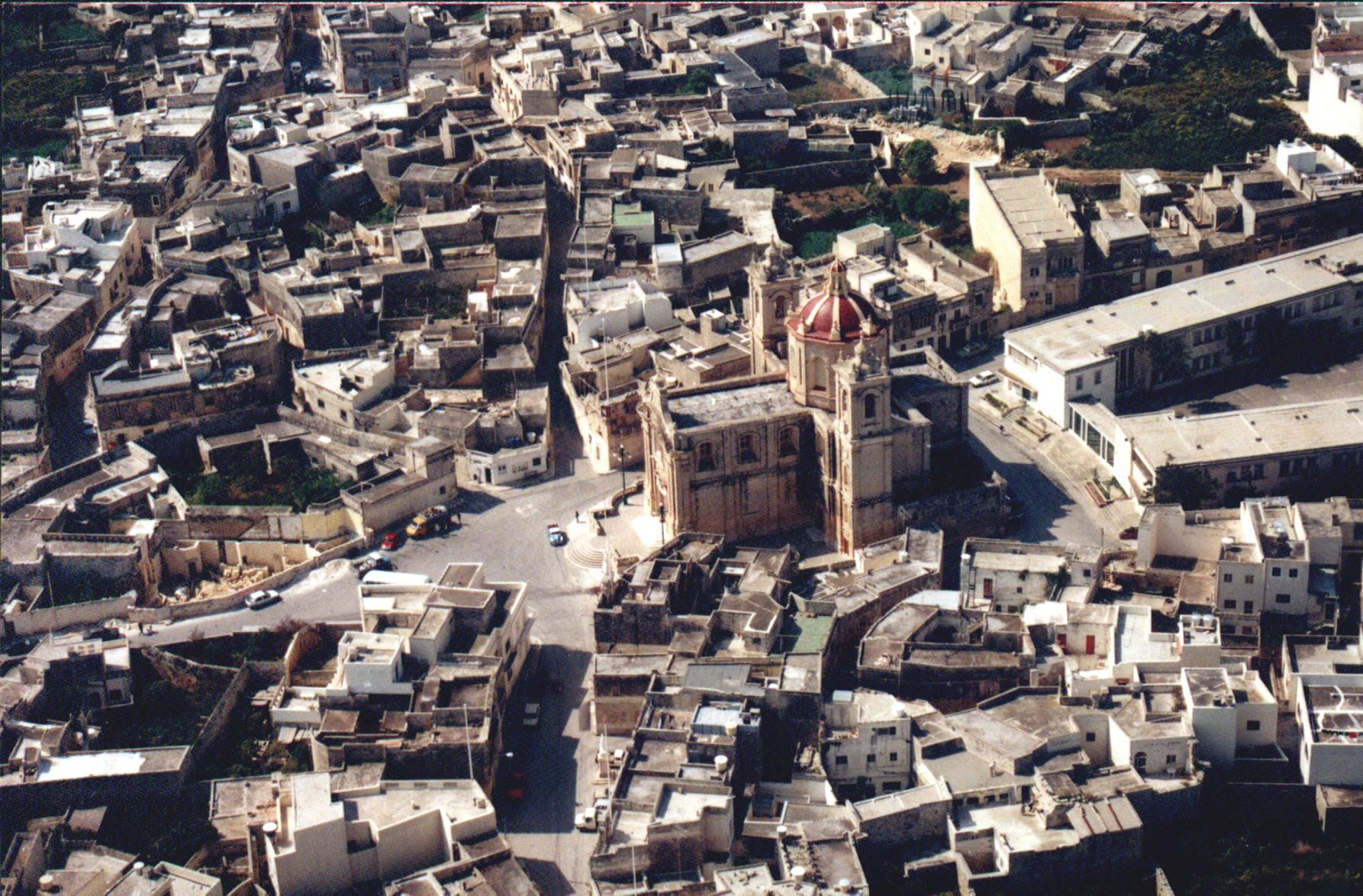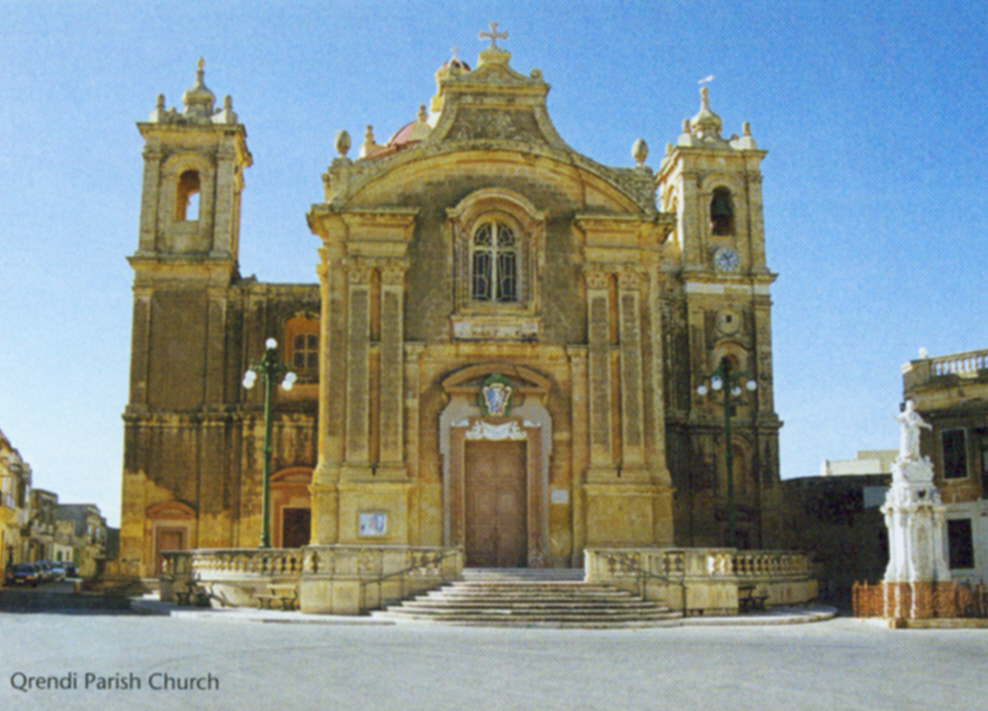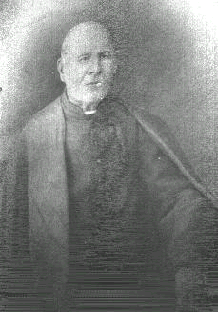
The Maltese Bishop Baldassare Cagliares proclaimed the Qrendi village a parish in 1618. Prior this date, the Qrendi inhabitants together with those from the two other small hamlets, those of Hal Manin and Hal Lew, attended religious services in the near parish of Zurrieq.
In 1620, Reverend John Mary Camilleri, decided to build a parish church on the highest site in the village, at a place where two other small chapels had previously stood. The temple was completed in 1655, thirty-five years later.
Hardly had a few years past from the church's completion when in 1677 Fr. Domenic Formosa became parish priest and decided to pull down his recently constructed church to build a bigger and larger one. The work began in 1685 and was completed in 1712, twenty-seven years later.
The Designs of the new church was entrusted to the distinguished Maltese architect of the time, Lorenzo Gafa'.
The dome and twin belfry towers on the either side characterize the crucifix form design of the church.
The transepts and the two side sacristies, with the choir and the main altar in the middle, forming the arms of the cross.



Whilst two of the four bells in the belfries were installed by 1712 in time to commemorate the church's completion, the remaining two were to be later additions, being installed in 1788 and 1798 respectively, during the time that Fr. Antonio Mizzi was parish priest.
Despite the fact that construction works on the church's building was completed by 1712, the church was to be consecrated seventy years later by Bishop Labini, on the 13th October 1782.



In the year 1882, on the initiative of a local priest, Fr. Celestino Camilleri, who was also a renowned botanist, the remains of St. Celestino were brought over from Rome and permanently displayed for all to see in the choir's altar behind the church's main altar.
Up to the early fifties, the church floor consisted of stone gravestone slabs that covered the tombs of its parishioners buried with the church, as was the practice of the time. These slabs were removed on the completion of the Qrendi cemetery, and the floor was covered with marble procured from Italy. This work under the supervision of the Italian craftsman Edoardo Lombardi was inaugurated on the feast of Corpus Christi in 1955. The interior design of the church's floor was that of the Maltese craftsman, Emanuel Buhagiar.


Ever since the Church's completion, distinguished local artists and craftsman have contributed in many ways to adorn this beautiful shrine.
The Titular painting, representing the Assumption of Our Lady into Heaven, located at the back of the main altar, is the distinguished work of the eminent Maltese artist, Giuseppe Cali'.
This magnificent oil painting measuring some 378 cm by 196 cm, was commissioned in 1919 when Cali' was nearly 70 years old, being originally destined for the Mqabba Parish Church and later acquired by the Qrendi Parishioners to add to its collections of church treasures.
Cali's painting replaced that of another Maltese Maestro, Rokku Buhagiar, who had originally been commissioned with a painting under the same title for the first church and which now hangs in the right sacristy.
Works by another fine Maltese craftsman, Emmanuel Buhagiar are the highly decorated frames of the fourteen Stations of the Cross together with the Lectern that is located in the choir behind the main altar.



The statue of the Assumption of Our Lady into Heaven, or as it is better known, Santa Marija, is carved out of a solid tree trunk and was commissioned in 1840 by the Maltese sculpture, Antonio Chircop.
Prior to its completion, a 16th century statue of the Immaculate Conception, brought over from Cospicua by Reverend Antonio Mizzi, parish priest of the time, was used during the procession on the feast of the Assumption in Qrendi.
The feast of Santa Marija is celebrated on the 15 August.


This statue of Our Lady of Lourdes was commissioned by the Maltese sculpture Karlo Darmanin in 1878, whilst the parish priest Fr. Pietro Paul Xuereb introduced the festivities of Our Lady of Lourdes in Qrendi during the same year, shortly after Our Lady's apparitions in Lourdes, France.
The feast of Our Lady of Lourdes is celebrated on the last Sunday in June
This altar in the left transept is dedicated to Our Lady of the Holy Rosary. The painting resembles the work of Giannikol Buhagiar, an 18th century artist.

 The other altar also in the left transept is dedicated to Our Lady of Mount Carmel.
The other altar also in the left transept is dedicated to Our Lady of Mount Carmel.
The painting is of an unknown artist. This altar is adorned with a very nice prospective of sculpture showing angels around this painting.
 This altar in the right transept is dedicated to the Crucifixion of Our Lord Jesus Christ.
This altar in the right transept is dedicated to the Crucifixion of Our Lord Jesus Christ.
The painting is of an unknown artist and has a superimposed large wooden cross hanging on it.
The altar is also dedicated to Our Lady of Lourdes and serves as the Arch confraternity's altar.
A smaller painting under the title of Our Lady of Lourdes also adorns this altar.
 This other altar in the right transept is dedicated to Pentecost.
This other altar in the right transept is dedicated to Pentecost.
The painting is of an unknown artist, represents the descent of the Holy Spirit.
This altar is adorned with a very nice prospective of sculpture showing angels around this painting similar to the 18th century Baroque style.
 This altar in the left side of main aisle is dedicated to Our Lady of Consolation.
This altar in the left side of main aisle is dedicated to Our Lady of Consolation.
The painting is the work of Ramiro Cali', son of Giuseppe Cali'.
Fr. Gwann Callus financed the painting.
 This altar also the left side of main aisle is dedicated to St. Stephen.
This altar also the left side of main aisle is dedicated to St. Stephen.
Stefano Erardi commissioned the painting in 1677, painted in thanksgiving at the end of the 1675 1676 black plague that claimed a good number of lives from
our village.
The painting depicts Archangels St. Michael and St. Gabriel with St. Stephen, St. Anne and St. Rosa of Lima.
 This altar also the left side of main aisle is dedicated to the Immaculate Conception of Our Lady.
This altar also the left side of main aisle is dedicated to the Immaculate Conception of Our Lady.
Stefano Erardi commissioned the painting that depicts Our Lady with St. Roque and St. Rosalie.
It is understood that this painting was also made as thanksgiving at the end of the plague.
 This altar also the right side of main aisle is dedicated to St. Paul.
This altar also the right side of main aisle is dedicated to St. Paul.
The painting is the work of Francesco Zahra and depicts St. John the Baptist, St. John the Evangelist, St. Paul, St. Catherine, St. Lucia and St. Nicholas.
 The only existing work by Giuseppe Calleja is found decorating the main pillar facing the altar. This painting configures Faith and as is known "Fides ex
Auditu"
The only existing work by Giuseppe Calleja is found decorating the main pillar facing the altar. This painting configures Faith and as is known "Fides ex
Auditu"
Giuseppe Calleja, born on the 12 December 1828, was a fine artist and has many paintings in various churches around the island.

 The Qrendi Parish once had the ceiling to its choir decorated with the painting of the King David the Prophet playing on a harp. Chev Raffael Bonnici Cali'
restored this work of art in 1948.
The Qrendi Parish once had the ceiling to its choir decorated with the painting of the King David the Prophet playing on a harp. Chev Raffael Bonnici Cali'
restored this work of art in 1948.
Unfortunately this painting was replaced by other interpretations in 1973.

Giuseppe Calleja donated the painting of St. Philip Neri to the Qrendi church in 1873, upon the completion of his paintings in this church.
This painting still hangs in the sacristy.
The Santa Maria Convoy is another of the works commissioned by the Gozitan artist, Paul Camilleri Cauchi.
The works represents the arrival on the 15th August 1942 at the Grand Harbour of the damaged tanker Ohio, one of the tankers that arrived safely to Malta bringing much needed food and supplies during "Operation Pedestal"
On the four main columns, which support the church's dome, are the Biblical figures of Ruth, Rachel, Abigail and Sefora, four women from the bible. The biblical paintings are the work of the Gozitan artist, Paul Camilleri Cauchi.


RUTH

RACQUEL

ABIGAIL

SEFORA
The eight paintings in this magnificent dome show different episodes in the life of Our Lady.
The Paintings were commissioned by Paul Camilleri Cauchi in 1971.

 A beautiful painting that replaced that of King David is found on the choir ceiling.
A beautiful painting that replaced that of King David is found on the choir ceiling.
In 1973, Paul Camilleri Cauchi commissioned the work that depicts the Ascension into heaven of Our Lady.
 The completion of the restoration on the 18th century Neapolitan pipe organ built in 1778 of the "Positivo" style was carried out in 2001.
The completion of the restoration on the 18th century Neapolitan pipe organ built in 1778 of the "Positivo" style was carried out in 2001.
The restoration works were carried out by Mr. Silvio Pace (decorations), Mr. Tony Bartolo (woodwork) and Mr. Robert Buhagiar (pipes,
electrical motor system and wind (manual) system).
The organ's restoration was inaugurated on the 22nd November 2001 with a musical recital at the Qrendi Parish Church under the
patronage of the President of the Republic of Malta, Prof Guido Demarco.
Acknowledgment
A very special friend and the
Qrendi Parish Web Master
(www.qrendiparish.org)